Loretta Ford, who co-founded the primary tutorial program for nurse practitioners in 1965, then spent a long time reworking the sector of nursing into an space of significant medical observe, training and analysis, died on Jan. 22 at her dwelling in Wildwood, Fla. She was 104.
Her daughter, Valerie Monrad, confirmed the dying.
In the present day there are greater than 350,000 nurse practitioners in America; it is among the quickest rising fields, and final 12 months U.S. Information and World Report ranked it the highest job within the nation, a mirrored image of wage potential, job satisfaction and profession alternatives.
That success is largely the results of a single particular person, Dr. Ford, who in 1965 co-founded the primary graduate program for nurse practitioners, on the College of Colorado, and subsequently mapped the outlines of what the sector entailed.
On the time, nurses have been necessary figures within the medical area, offering not simply administrative help but additionally important companies the place and when medical doctors have been unavailable. However the coaching and profession framework for nurses was nearly fully absent.
“In nurses’ coaching, the main target is an excessive amount of on educating and administration,” Dr. Ford stated in a speech at Duke College in 1970. “We wish to make the nurse right into a clinician.”
She went additional in 1972, when she was employed as the primary dean of the varsity of nursing on the College of Rochester. There she carried out the “unification” mannequin of nursing, wherein training, observe and analysis are absolutely built-in.
“It offers the occupation the flexibility to check itself with the analysis, and have nurse-practitioner researchers conducting that work whereas educating the longer term work pressure,” Stephen A. Ferrara, the president of the American Affiliation of Nurse Practitioners, stated in an interview.
Dr. Ford’s work within the Seventies typically confronted resistance from medical doctors, who scoffed on the thought of nurses wielding affect throughout the medical area and, maybe, threatening their dominance of it.
“We really bought hate letters within the mail,” Eileen Sullivan-Marx, who studied below Dr. Ford at Rochester and is now the dean emerita of the varsity of nursing at New York College, stated in an interview.
However Dr. Ford and others pushed on, establishing state-level licensing protocols, standardizing curriculums and adjusting insurance coverage applications to permit nurse practitioners to have a substantive, and sometimes impartial, function throughout the well being care system.
And he or she emphasised that nurse practitioners weren’t there to switch medical doctors however to enrich them — to do the frontline work in hospitals, but additionally to be out in the neighborhood, targeted on well being and prevention at a grass-roots stage.
“It was apparent to me,” she advised Wholesome Ladies journal in 2022, “that we wanted superior abilities and an expanded information base to make the selections. As a result of it occurs in a hospital. Who do they suppose makes selections at 3 a.m.?”
Loretta Cecelia Pfingstel was born on Dec. 28, 1920, within the Bronx and raised in Passaic, N.J. Her father, Joseph, was a lithographer, and her mom, Nellie (Williams) Pfingstel, oversaw the house.
As a baby, Loretta hoped to grow to be a instructor, however the onset of the Nice Melancholy hit her household’s funds exhausting, and he or she was compelled to search out work at 16. She grew to become a nurse, and in 1941 earned a diploma in nursing from Middlesex Basic Hospital in New Jersey.
Her fiancé was killed in fight in 1942, inspiring her to hitch the U.S. Military Air Forces, desiring to be a flight nurse. However her poor eyesight disqualified her from flying, and by the tip of the struggle she was based mostly at a hospital in Denver.
She obtained a bachelor’s diploma in nursing in 1949 from the College of Colorado, and a grasp’s in public well being there in 1951.
Early in her profession she specialised in pediatric public well being, whereas additionally educating within the nursing program on the College of Colorado; by 1955 she was an assistant professor, and in 1961 she earned a doctorate in training from the varsity.
She married William J. Ford in 1947. He died in 2014. Their daughter is her solely survivor.
Dr. Ford’s work took her into rural elements of Colorado, the place medical doctors have been few, poor households have been many and the necessity for fundamental preventive medical care was acute. She discovered herself enjoying many roles below the title “nurse” — she was half public well being official, half counselor, half all-around clinician.
On the identical time, the Kennedy and Johnson administrations have been bringing a brand new sense of urgency to the problems of rural public well being and supporting innovation throughout all medical fields.
Working alongside Henry Silver, a pediatrician at Colorado, Dr. Ford created a graduate program for nurses, although at first it was within the type of persevering with training, and not using a diploma. However the kernel of her imaginative and prescient was already there: that nurses ought to be sufficiently skilled to make impartial selections, have their very own practices and take part in well being care as a part of a group.
“Full independence for any well being practitioner at present is a fable,” she stated at Duke. “It could possibly be downright poor observe.”
By the point she retired from Rochester, in 1986, there have been hundreds of licensed nurse practitioners, and lots of medical doctors had come to just accept them as colleagues, not supporting gamers.
Dr. Ford continued to jot down and lecture, and in 2011 she was inducted into the U.S. Ladies’s Corridor of Fame.
“I get a whole lot of credit score for 140,000 nurses, and I don’t deserve it,” she stated in her acceptance speech. “They’re those who fought the nice battle. They took the warmth, they usually stood it, they usually’ve completed fantastically.”








